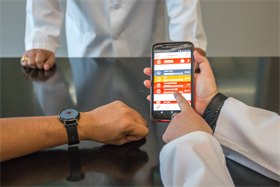Many of our nation’s returning war veterans suffer from post-traumatic stress disorder (PTSD), a psychiatric disorder that can occur after experiencing or witnessing a traumatic event. The number of veterans who were diagnosed with PTSD varies by service era. For every 100 veterans who took part in the war in Afghanistan, about 11 to 20 percent experience PTSD in a given year.
Researchers from the Department of Industrial and Systems Engineering, School of Public Health and College of Medicine at Texas A&M University are collaborating to develop an intelligent information system for veterans with PTSD that has the potential to save millions of lives.
“We’re designing a system that utilizes sensor-enabled wearable technologies to monitor PTSD patients remotely, and to monitor their condition outside of a clinical setting,” said Dr. Farzan Sasangohar, an assistant professor in industrial and systems engineering.
People with PTSD can suffer from what are known as arousal symptoms, which causes them to constantly be on the look-out for any signs of danger and can lead to outbursts of anger or irritability, or flashbacks to a traumatic moment. These symptoms can happen at any time and make one’s daily routine extremely difficult, or in some cases, impossible to get through.
To help manage their condition, some veterans engage in in-person therapy sessions with a specialized clinician. However, with the rising popularity of sensor-enabled wearable technologies and the emergence of mHealth applications, patients now have the ability to continue their care outside of their regularly scheduled sessions by completing periodical assessments and being engaged in therapeutic activities. Although PTSD apps are used by many, they are standalone devices that have significant usability issues and do not have the ability to report helpful feedback to the clinician.
“User engagement is a general limitation of current remote health technologies including current PTSD mHealth apps,” said Sasangohar. “They do not provide a closed loop, so no information is being sent to the clinician. The new system the research group is developing will be able to passively collect continuous information on a patient’s well-being and send it to their clinician.”
 The information clinicians receive will help them make more holistic evaluations of their patients, which then leads to more informed therapy sessions. In addition to helping out clinicians, using remote health technology is a more cost effective and efficient method for patients to get the help they need.
The information clinicians receive will help them make more holistic evaluations of their patients, which then leads to more informed therapy sessions. In addition to helping out clinicians, using remote health technology is a more cost effective and efficient method for patients to get the help they need.
Sasangohar’s new system will use wearable devices such as smartwatches and smartphones to identify episodes of non-normal activities (physical or biophysical) primarily using the patient’s heart rate during periods of hyper-arousal, which is a state of increased psychological and physiological responses, and will engage the patient in an interactive assessment to get an idea of their condition in that moment. Based on the patient’s answers, the system will either route them to an emergency support system, connect them to a clinician, or engage them in an activity like relaxation or breathing techniques.
The system will have the ability to pick up a patient’s heart rate, identify the patient’s physical state and use it to identify if a PTSD symptom is emerging. The group has evidence that shows mental state change is correlated to heart rate variability.
The research group started work on this project in 2015 and is currently conducting validation testing on a prototype of the new system to ensure that when given to PTSD patients for field testing, various noises from their surrounding environments will not adversely affect the physiological feedback. Once validation testing is completed and it has a final product, the group would like to collaborate with the U.S. Department of Veteran Affairs in order to share the technology with veterans.
In July, Sasangohar received a seed grant from the Texas A&M Engineering Experiment Station (TEES), the Texas A&M University College of Engineering and the Texas A&M University Division of Research for his proposal, “Effective Management of PTSD: A Systematic Design and Investigation of a Novel PTSD Information System for Veterans.”
This project is part of a portfolio of smart sensing projects in Sasangohar’s Cognitive Ergonomics Lab. This new system will not only be able to help PTSD patients, but also those with general depression or dementia.
“The goal of all the projects is to provide affordable, non-intrusive bio-sensing systems to improve patient safety in a wide range of healthcare environment solutions,” he said.
“If I know the technology that I provide or contribute to will save even one life, personally that satisfies me. This kind of technology has the prospect of saving millions of lives. It really paves the way for affordable solutions to improve the quality of care, patient safety and help patients with mental disorders in general.”